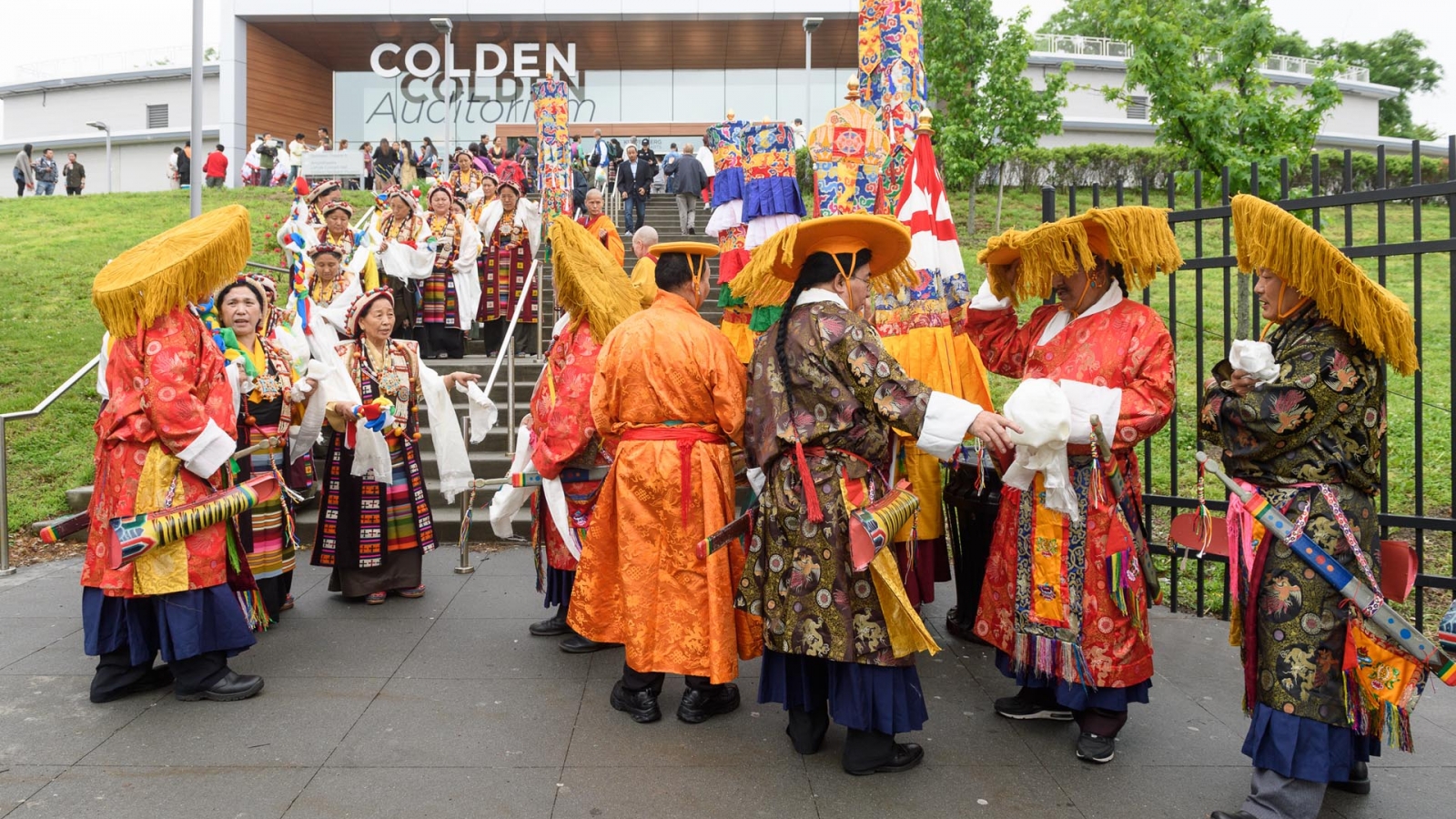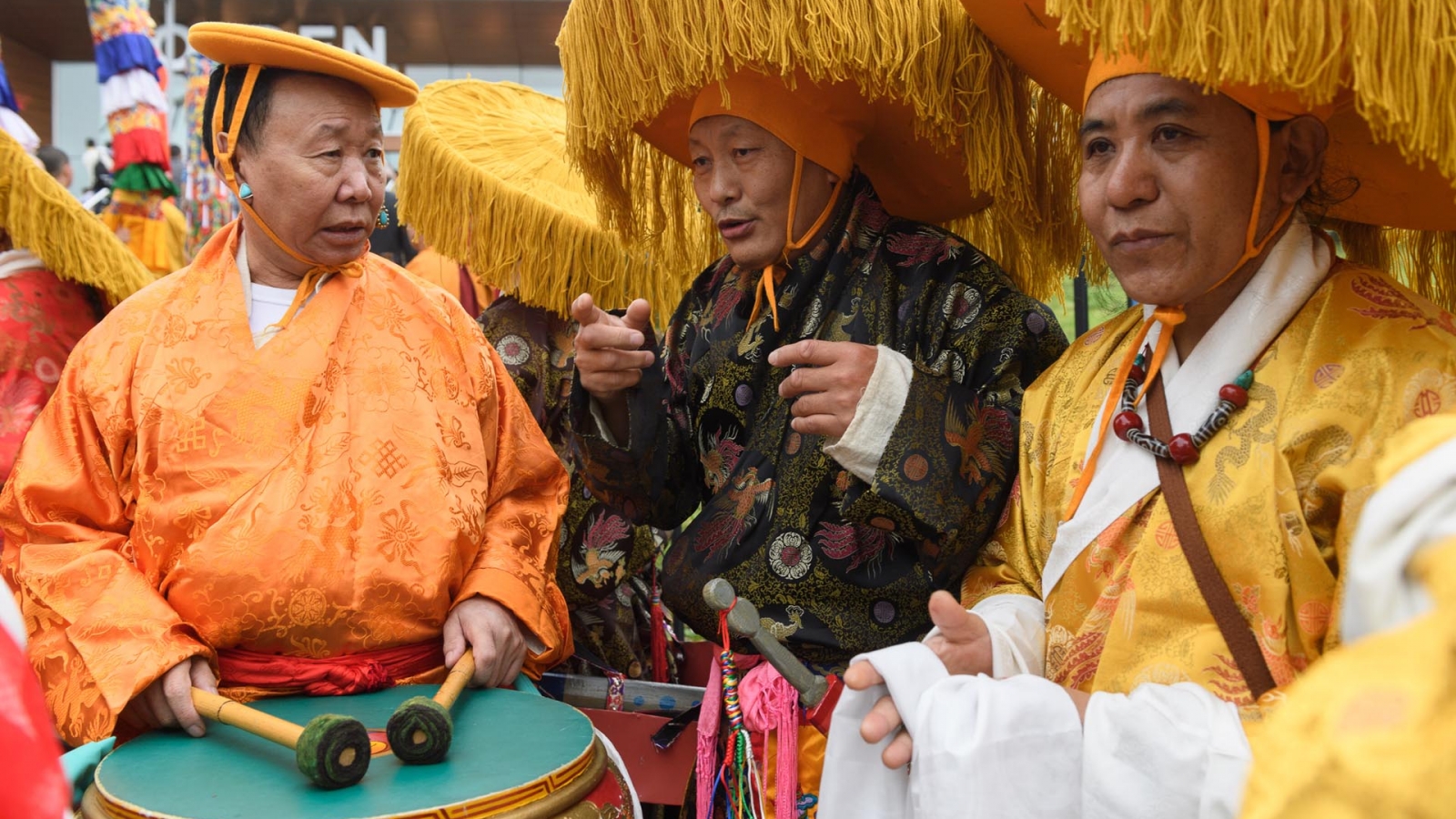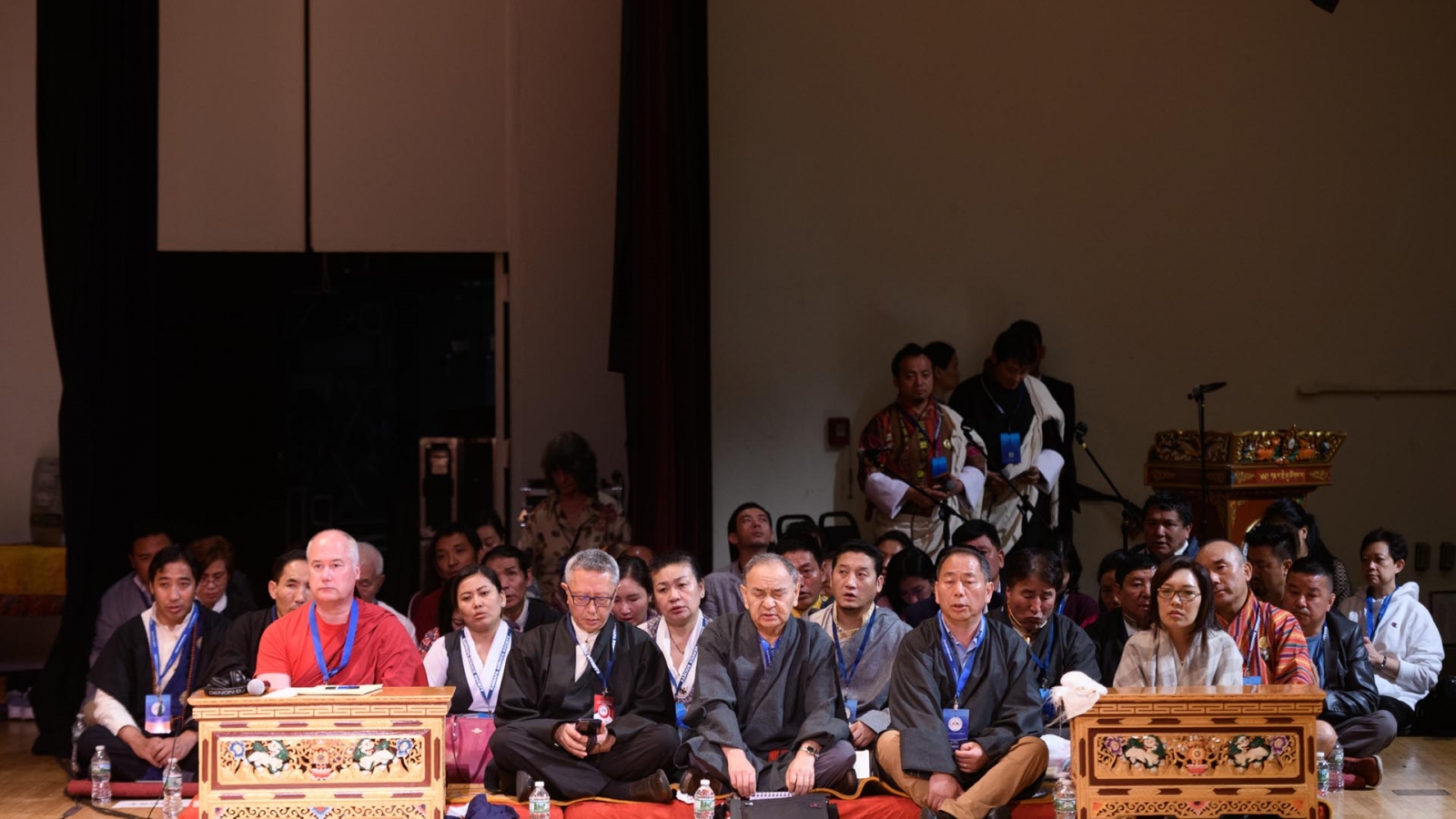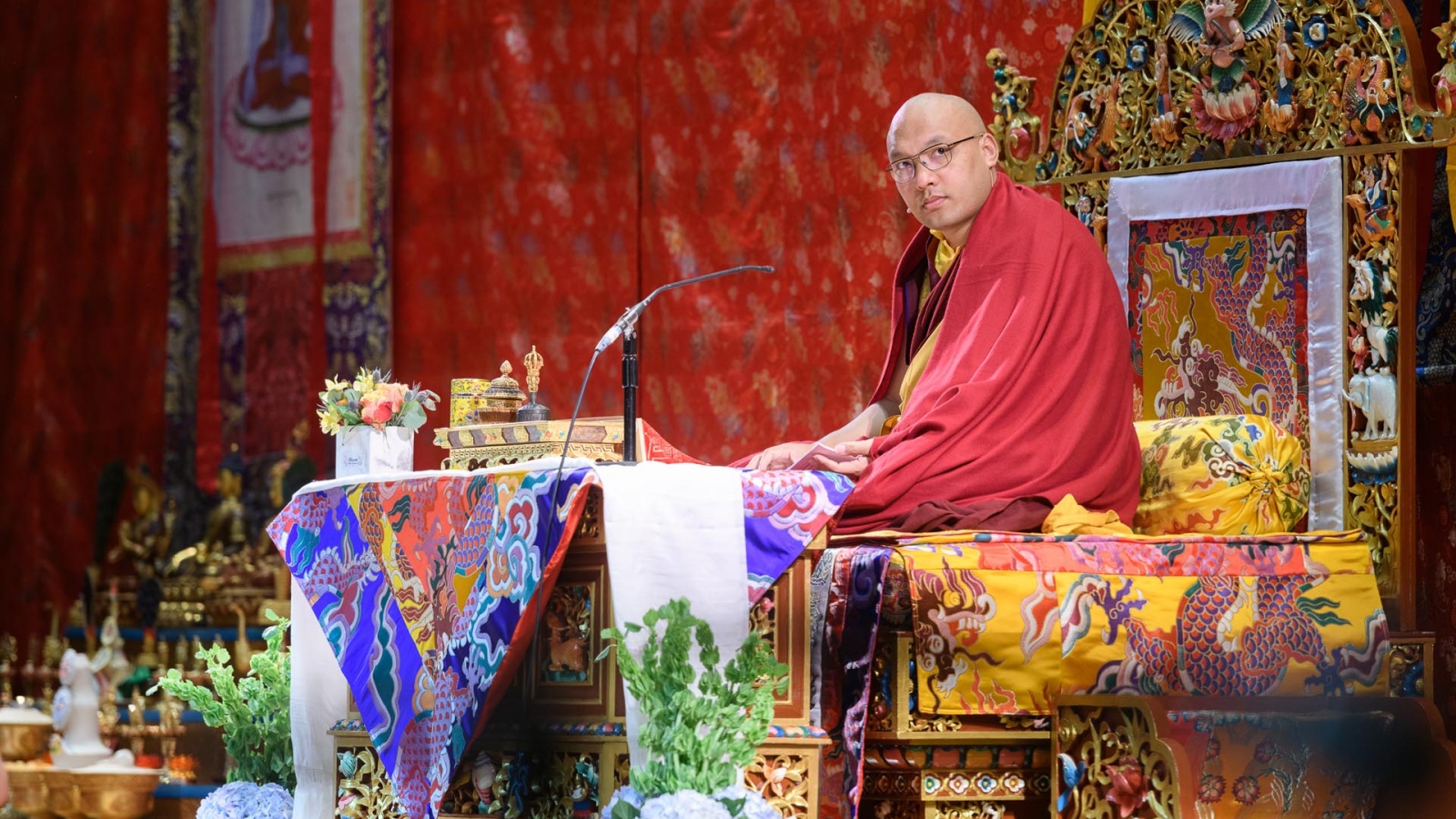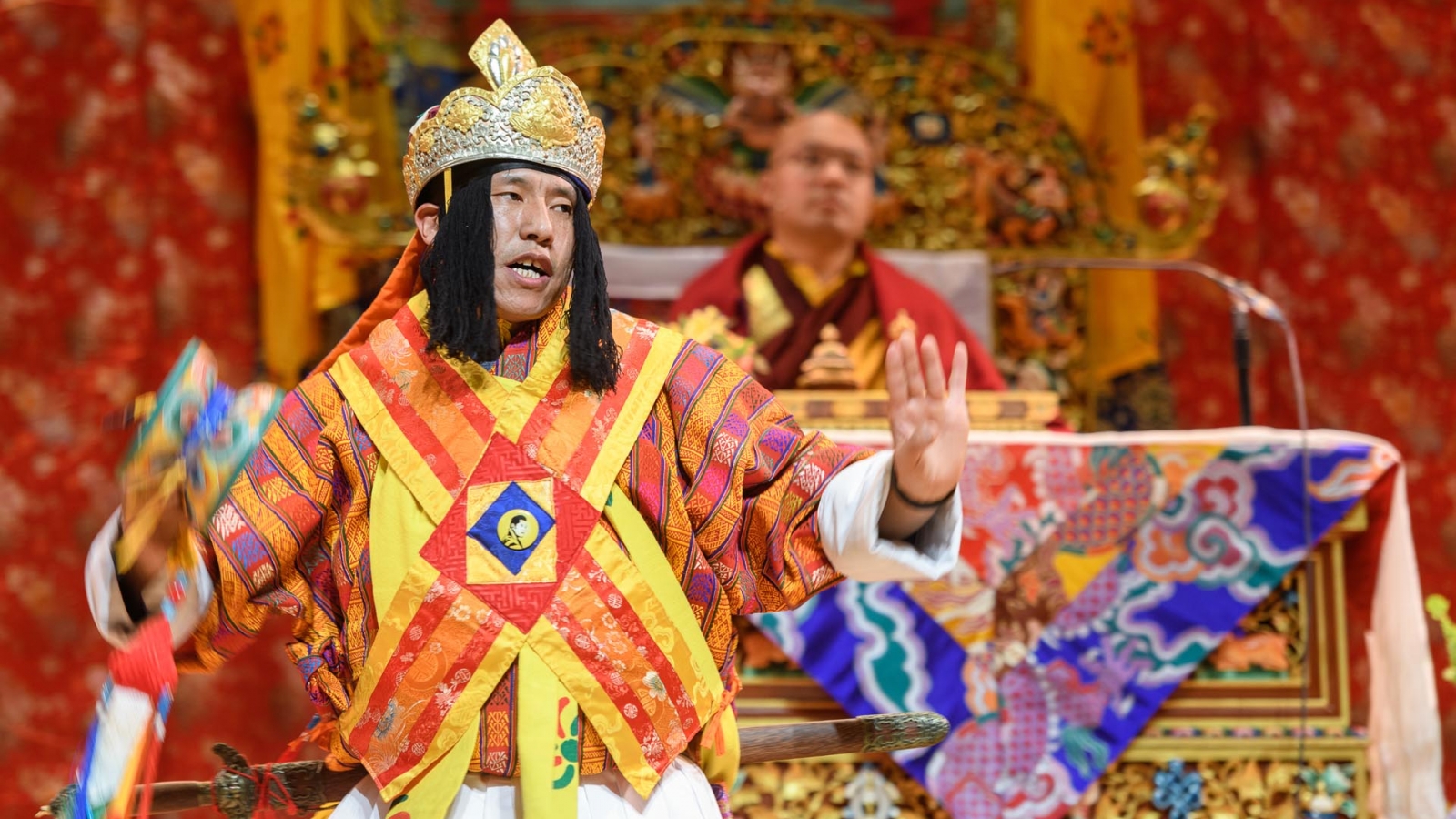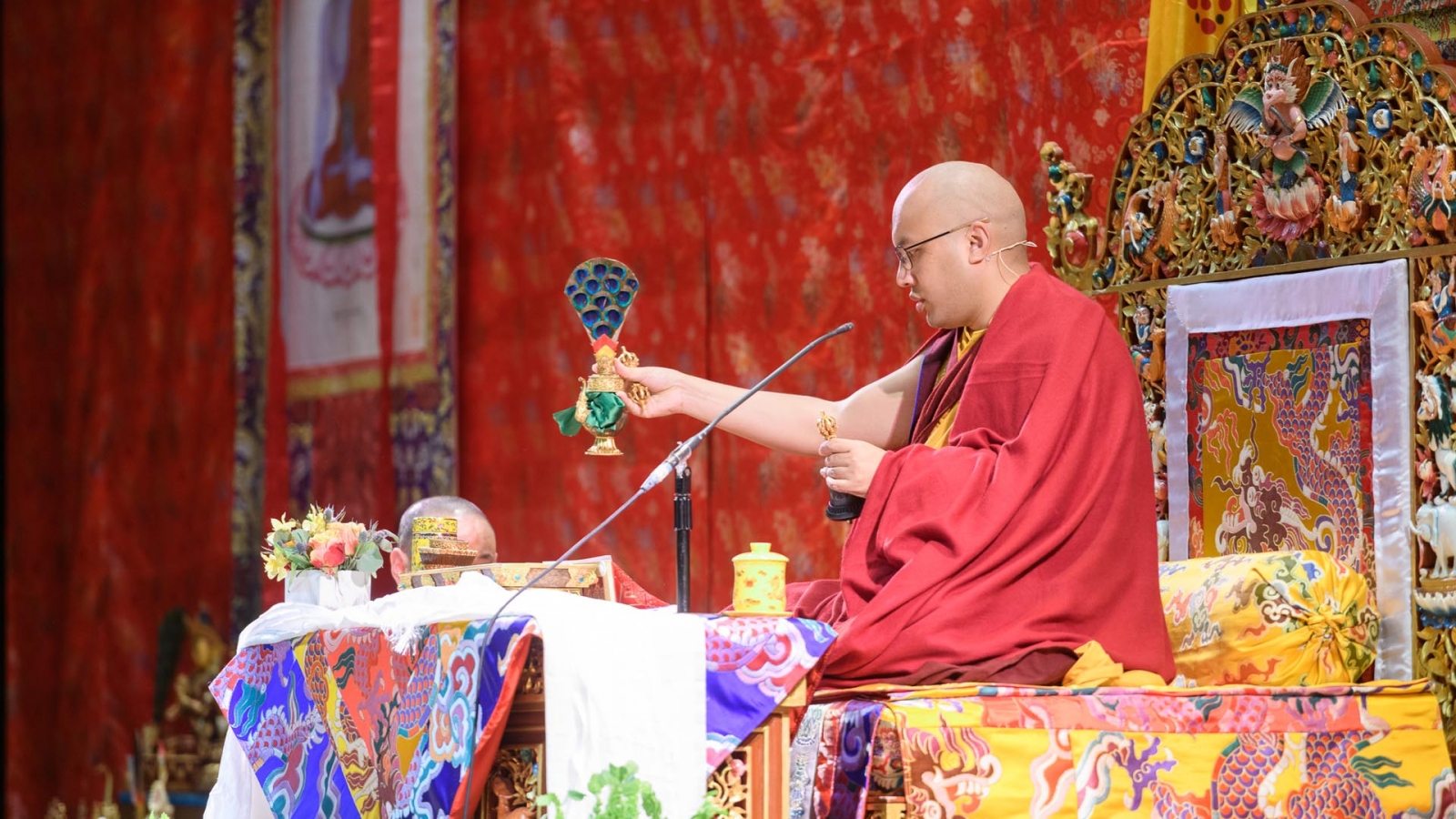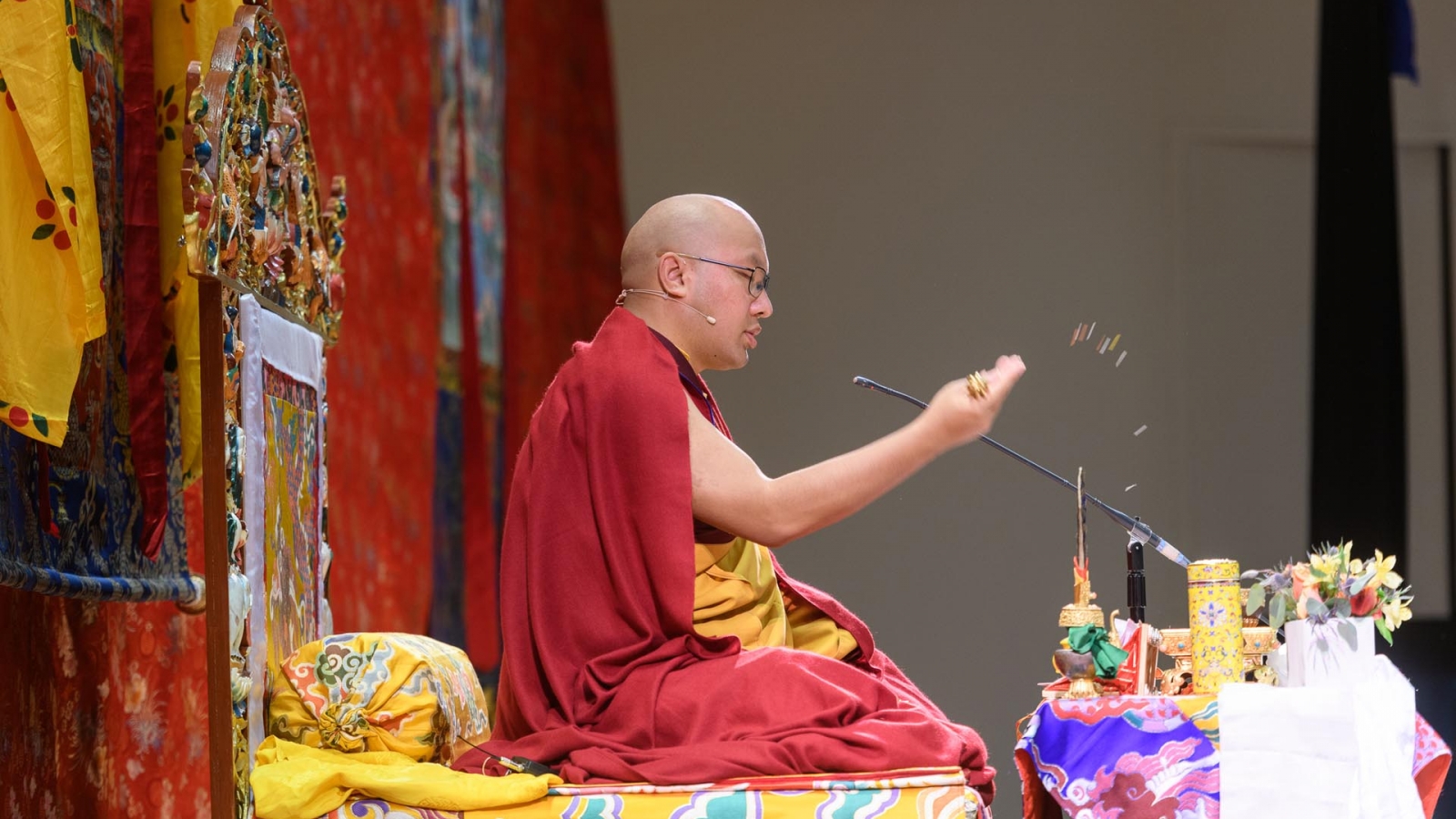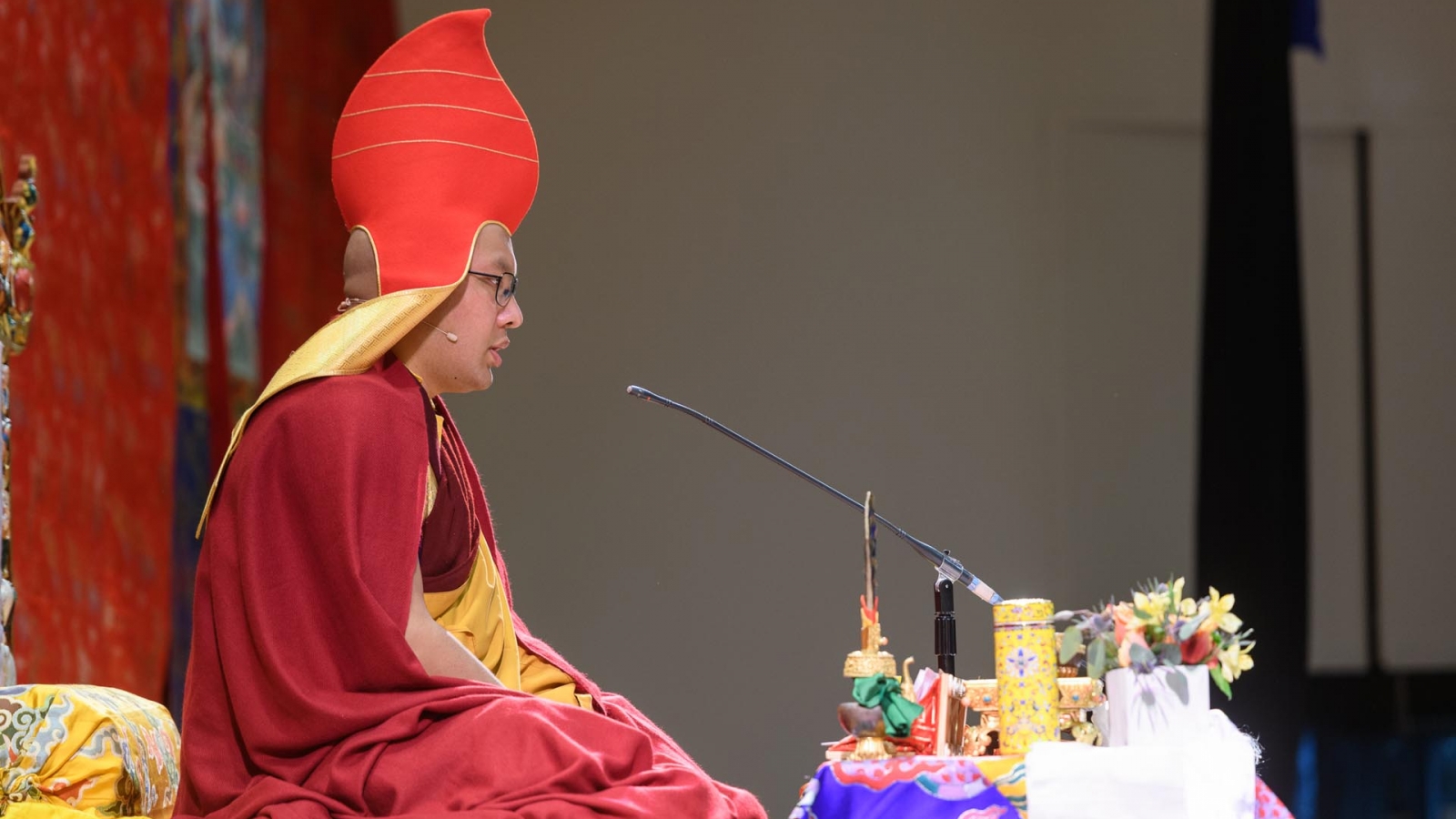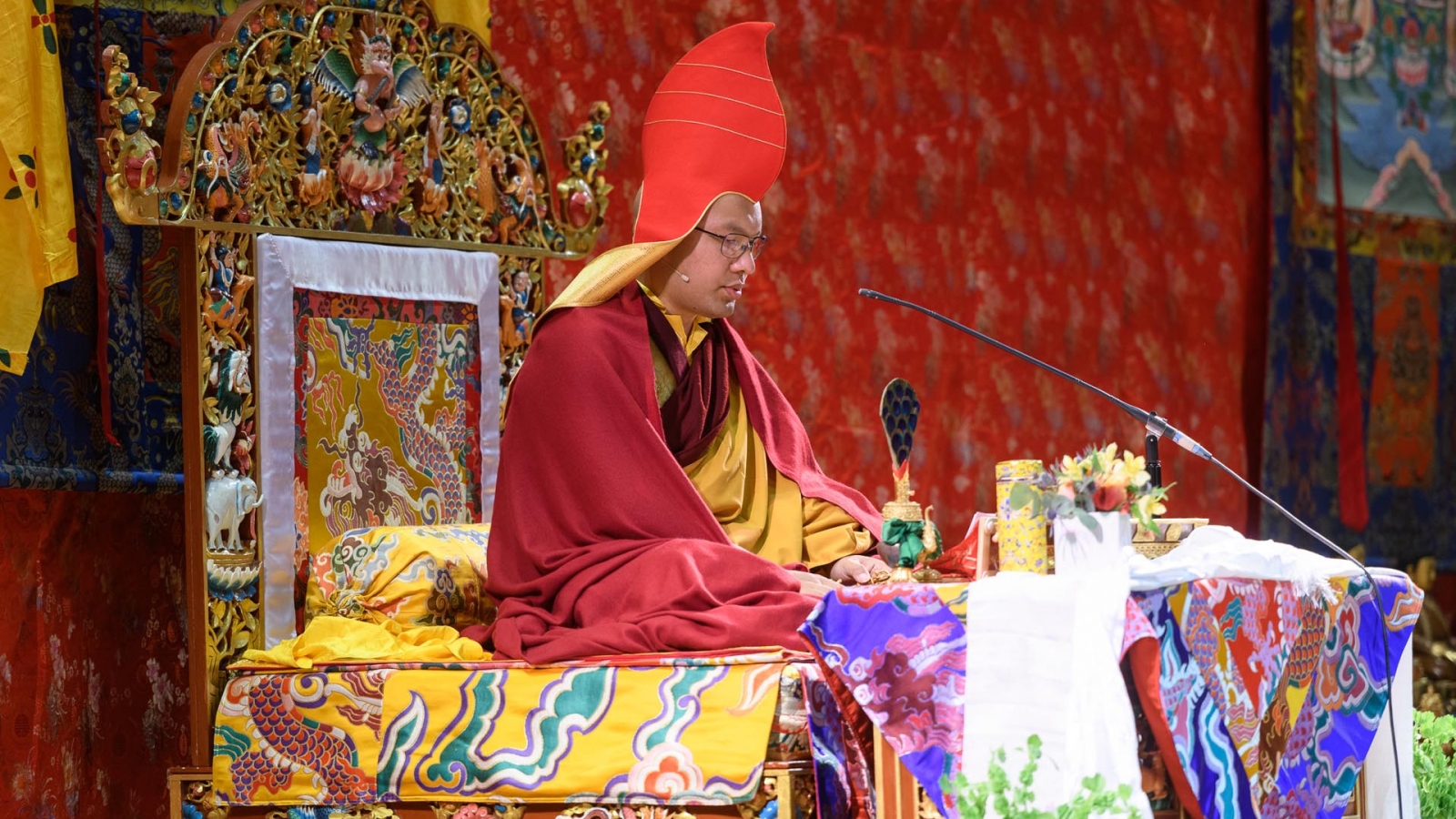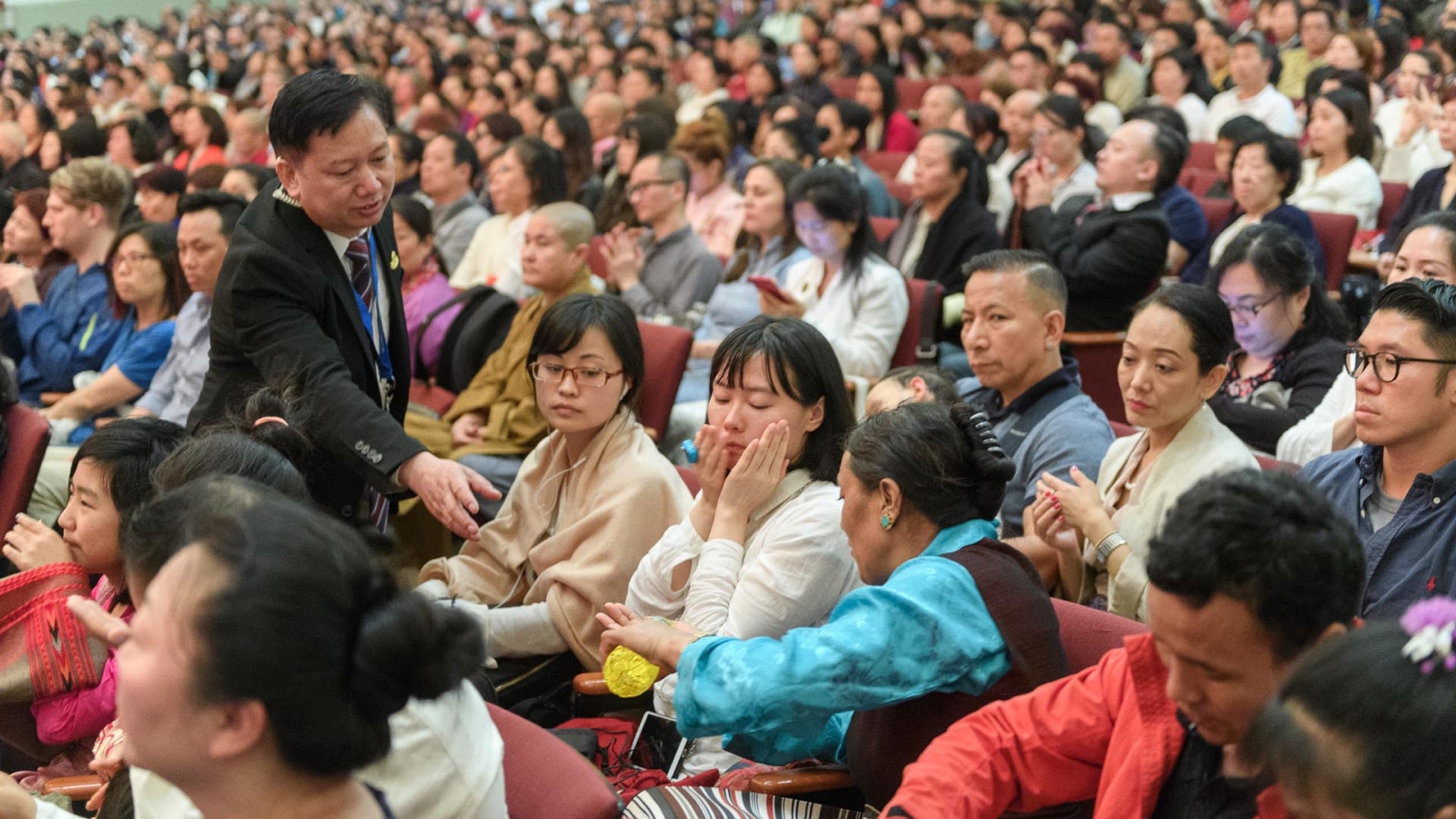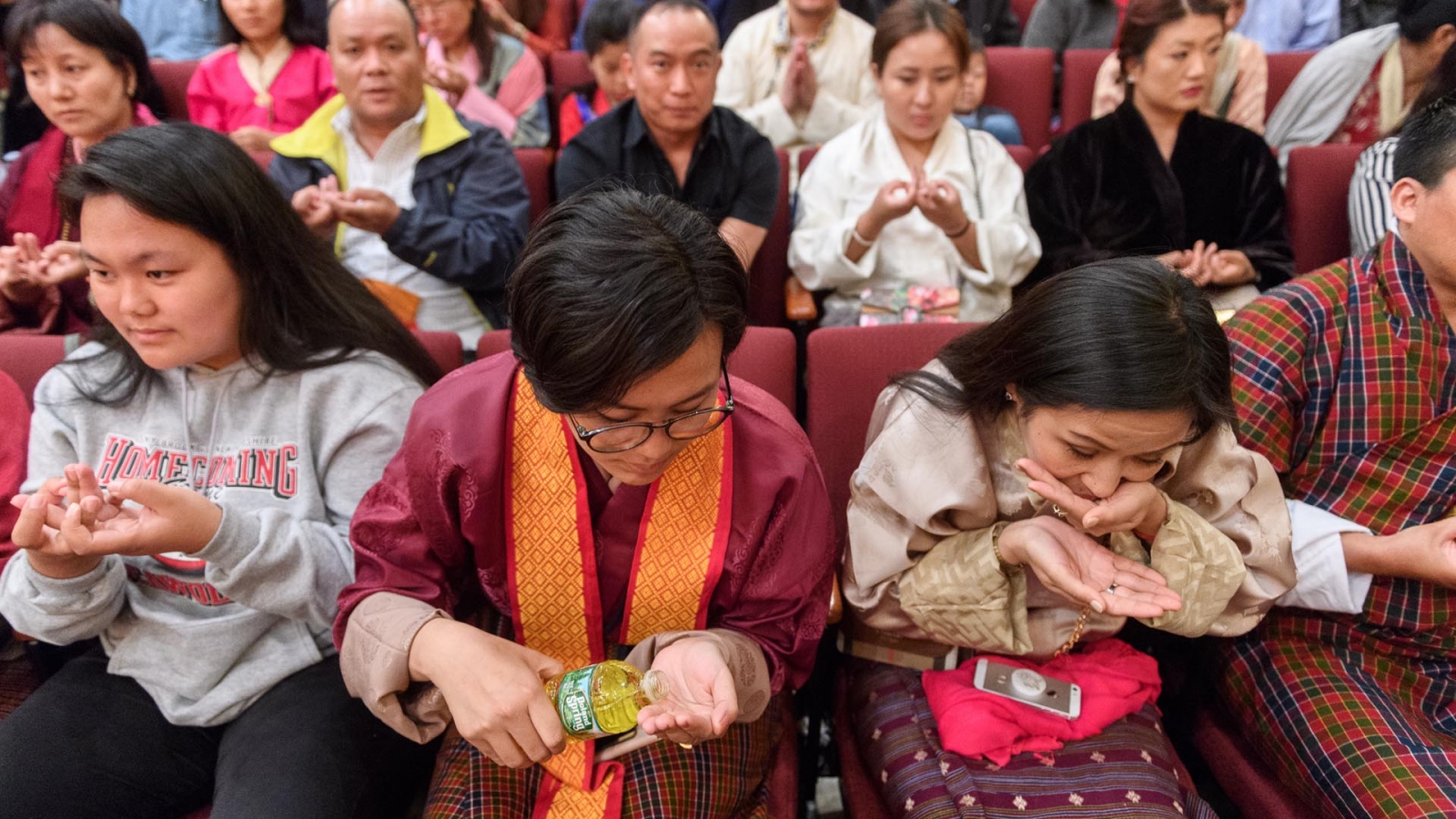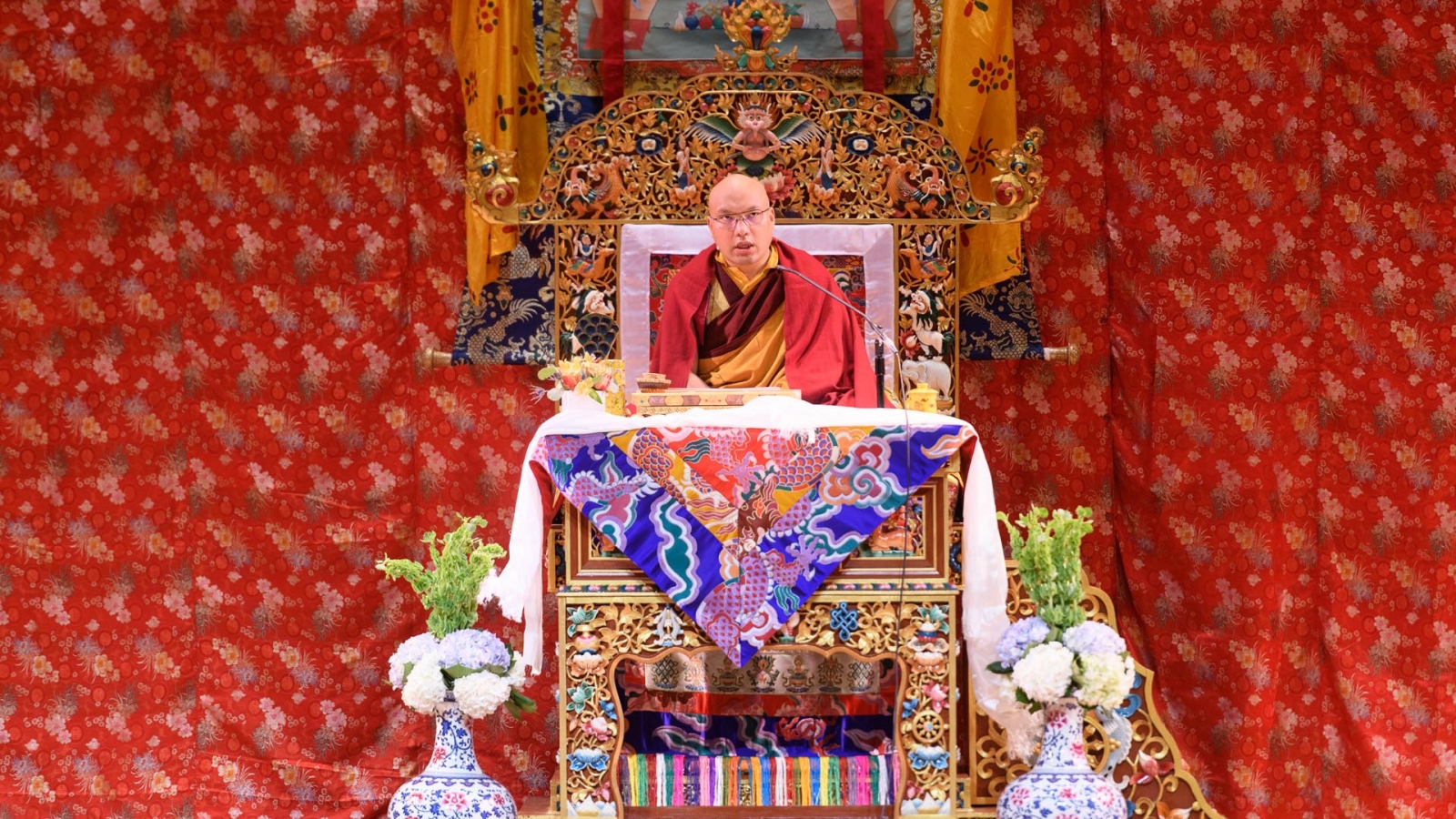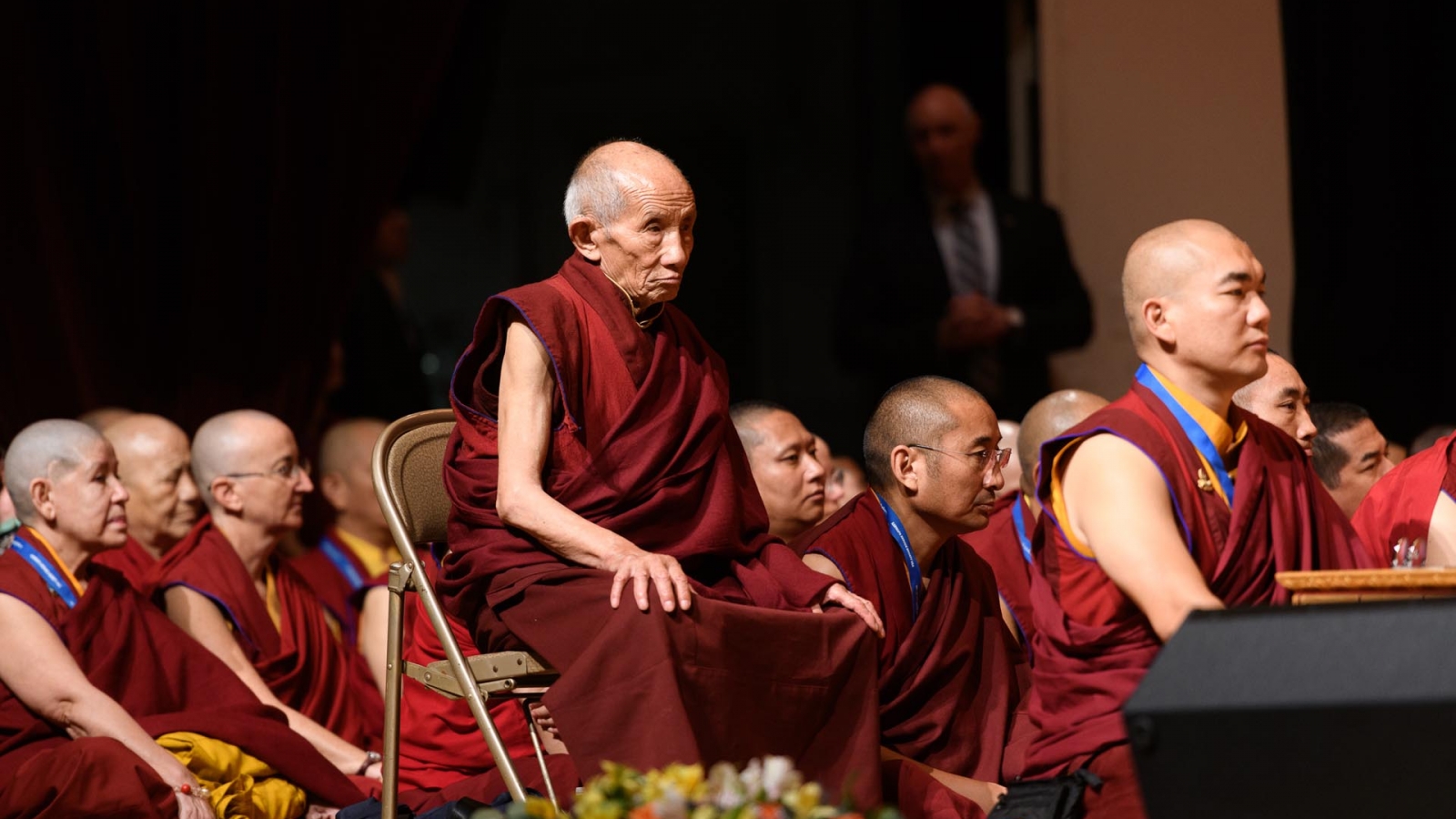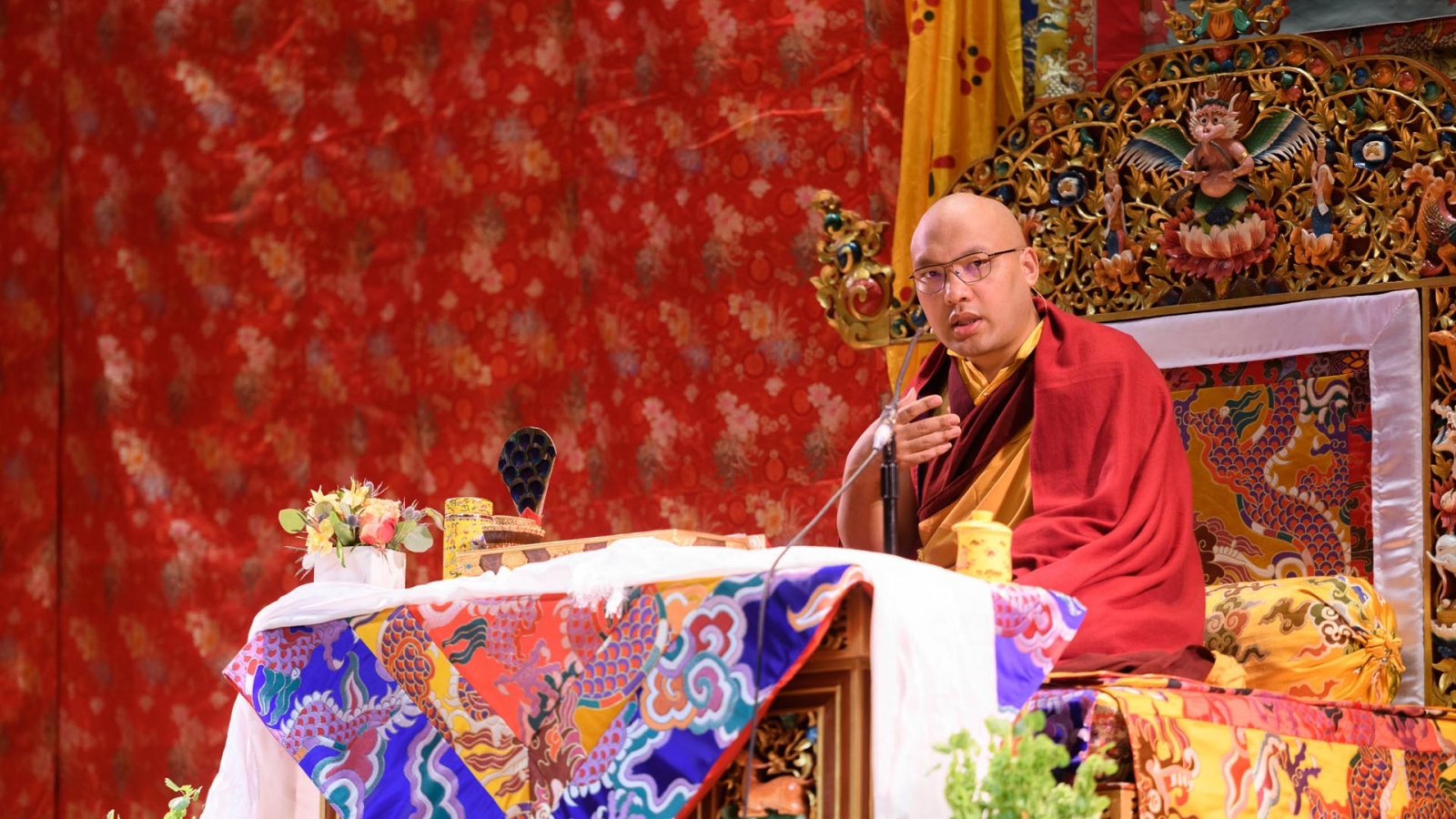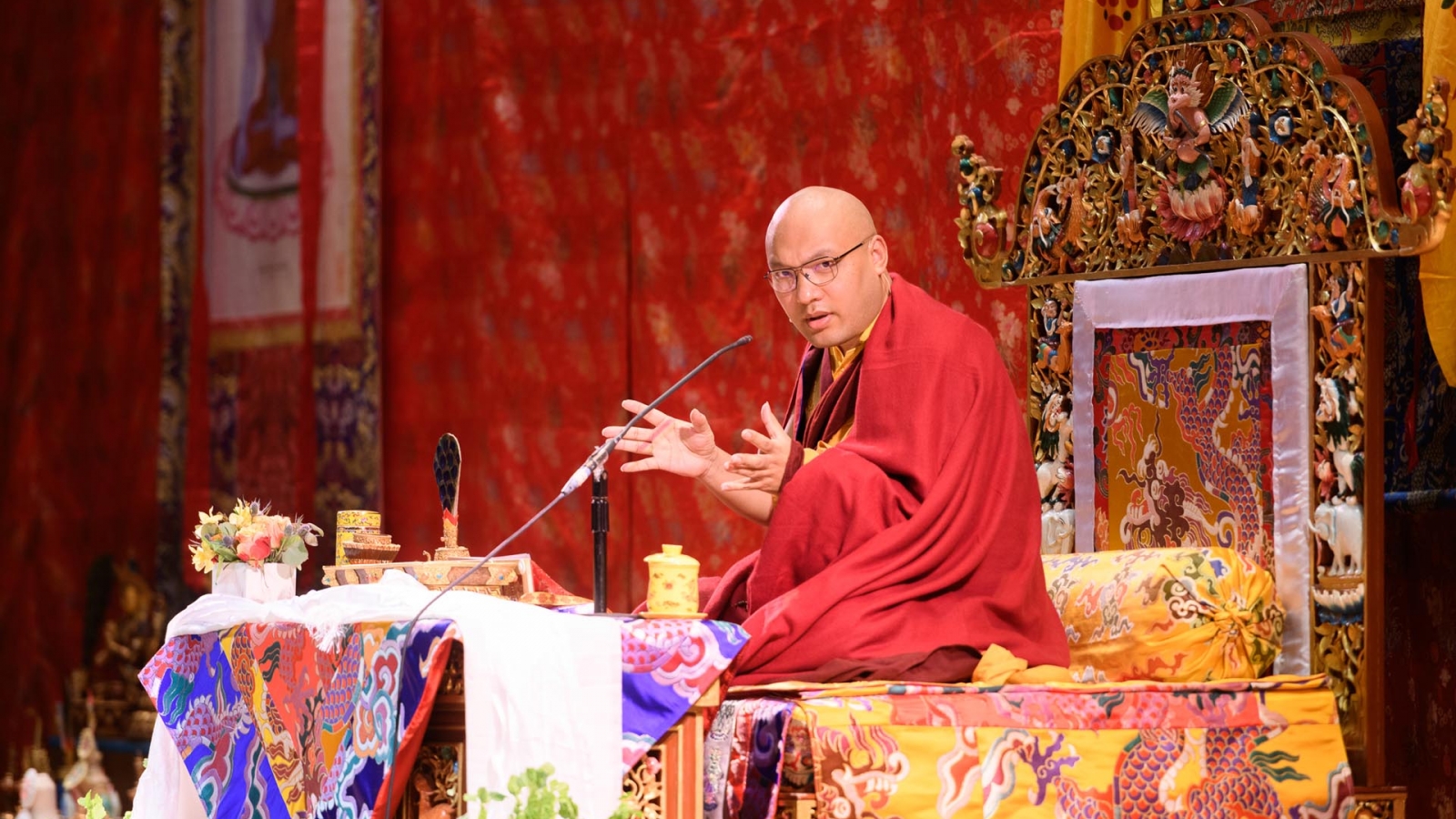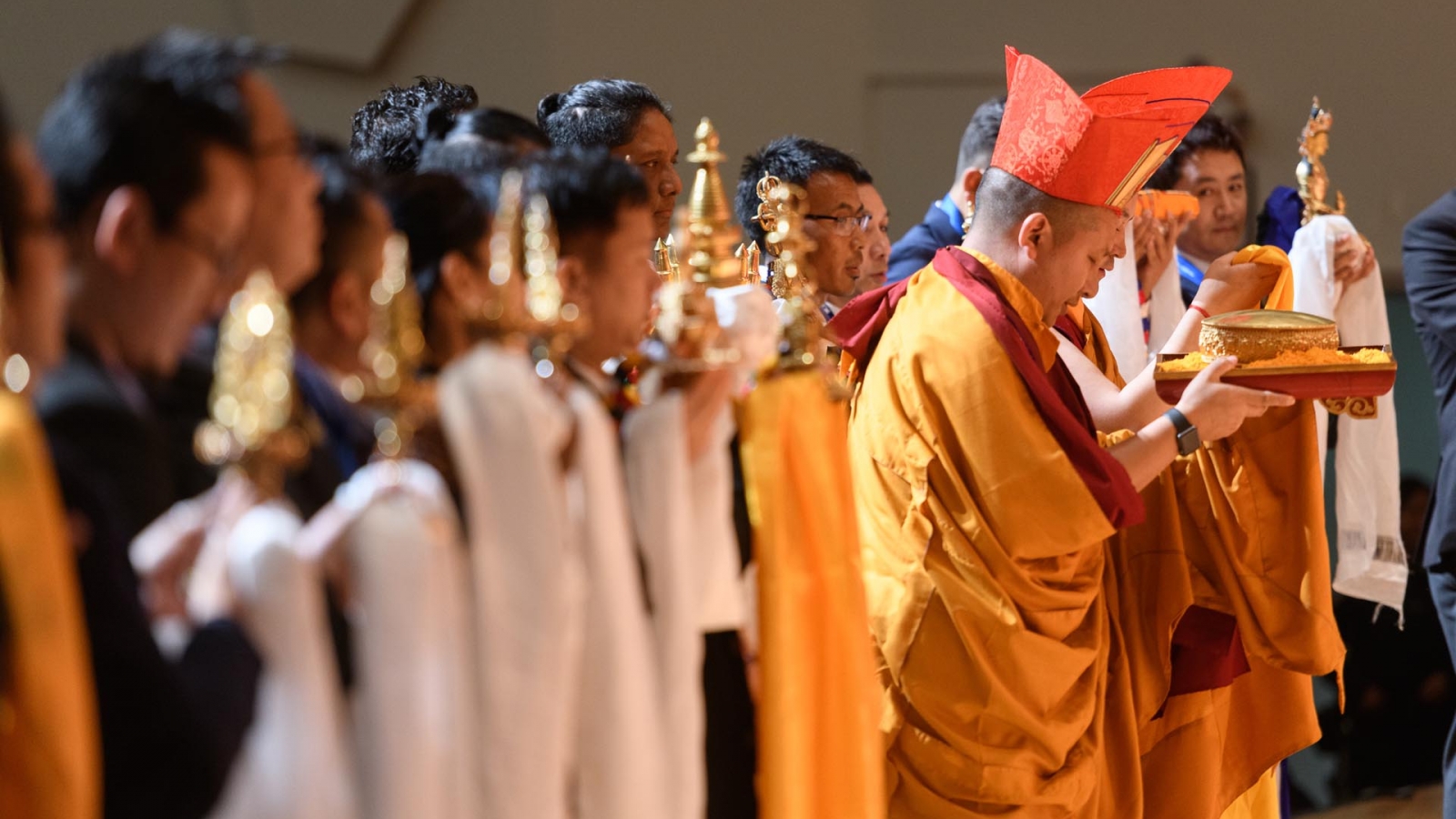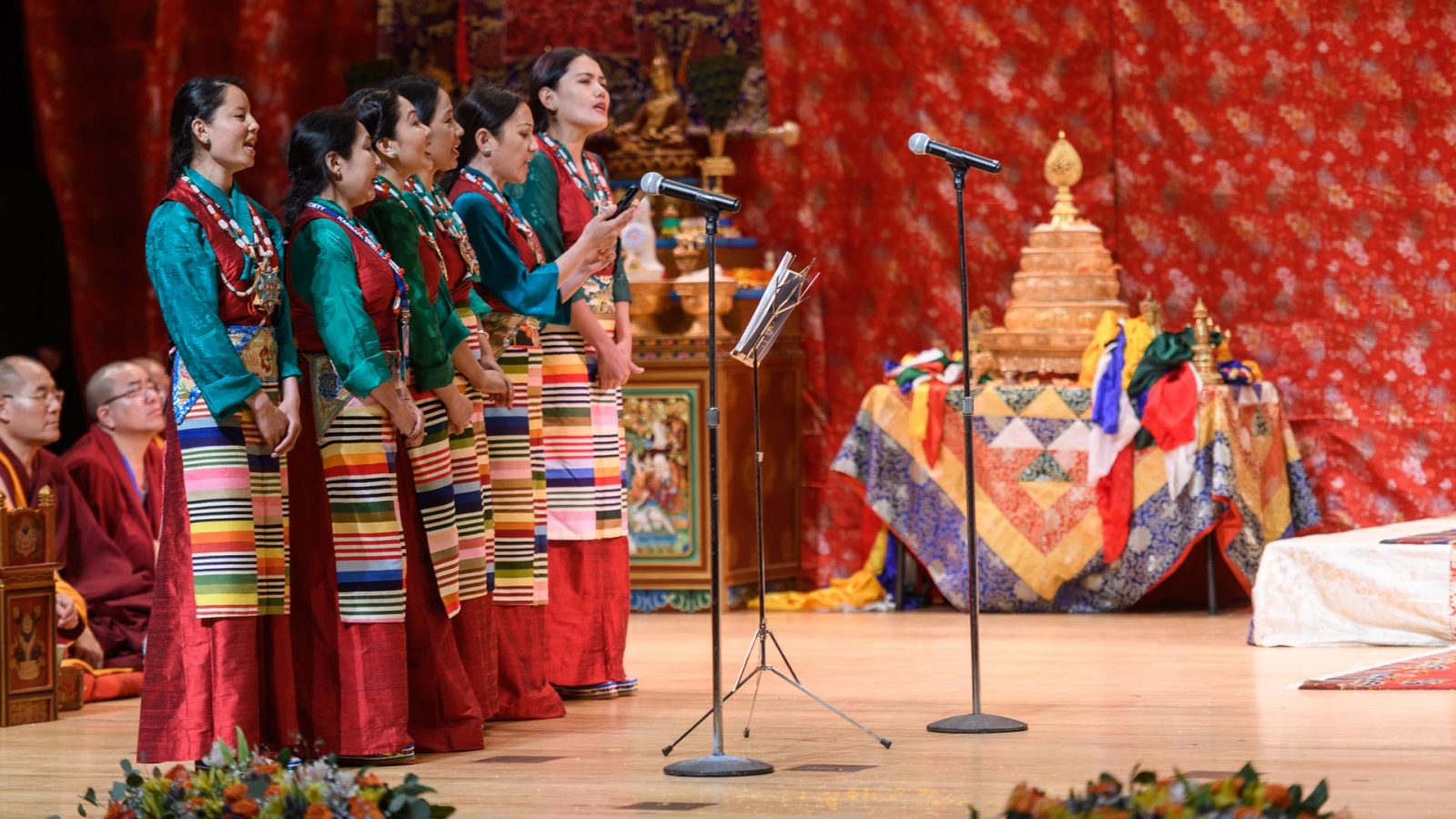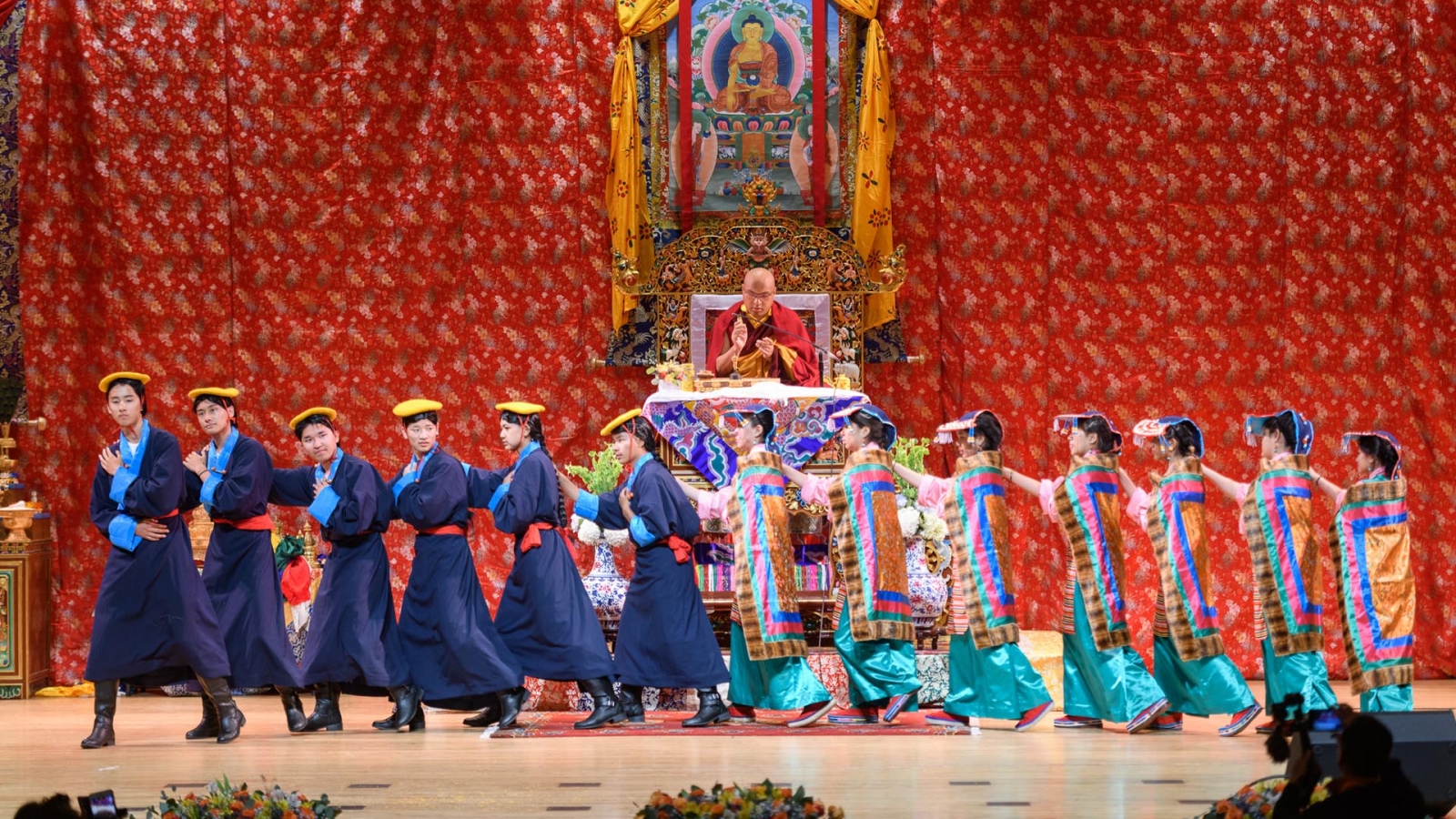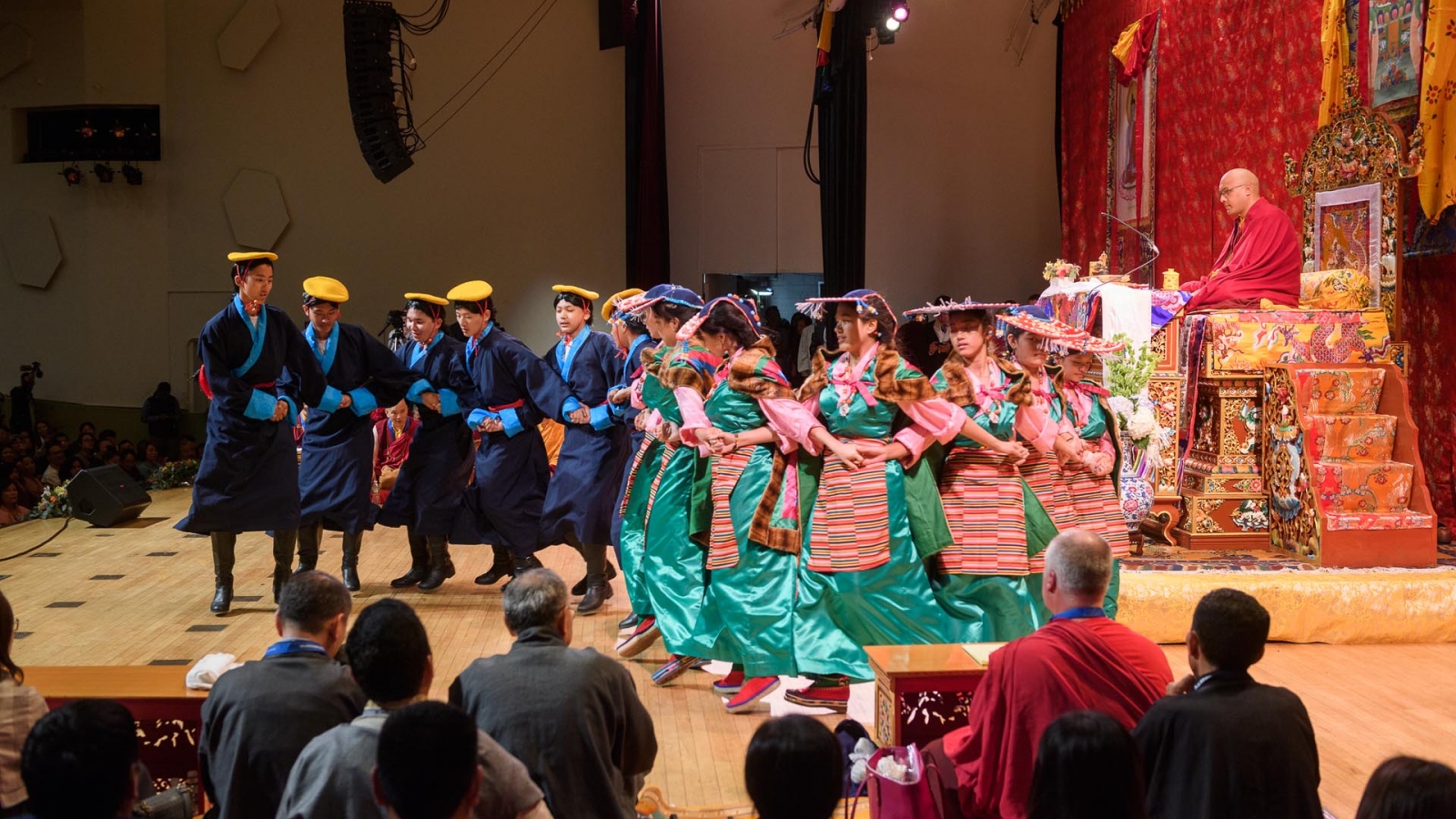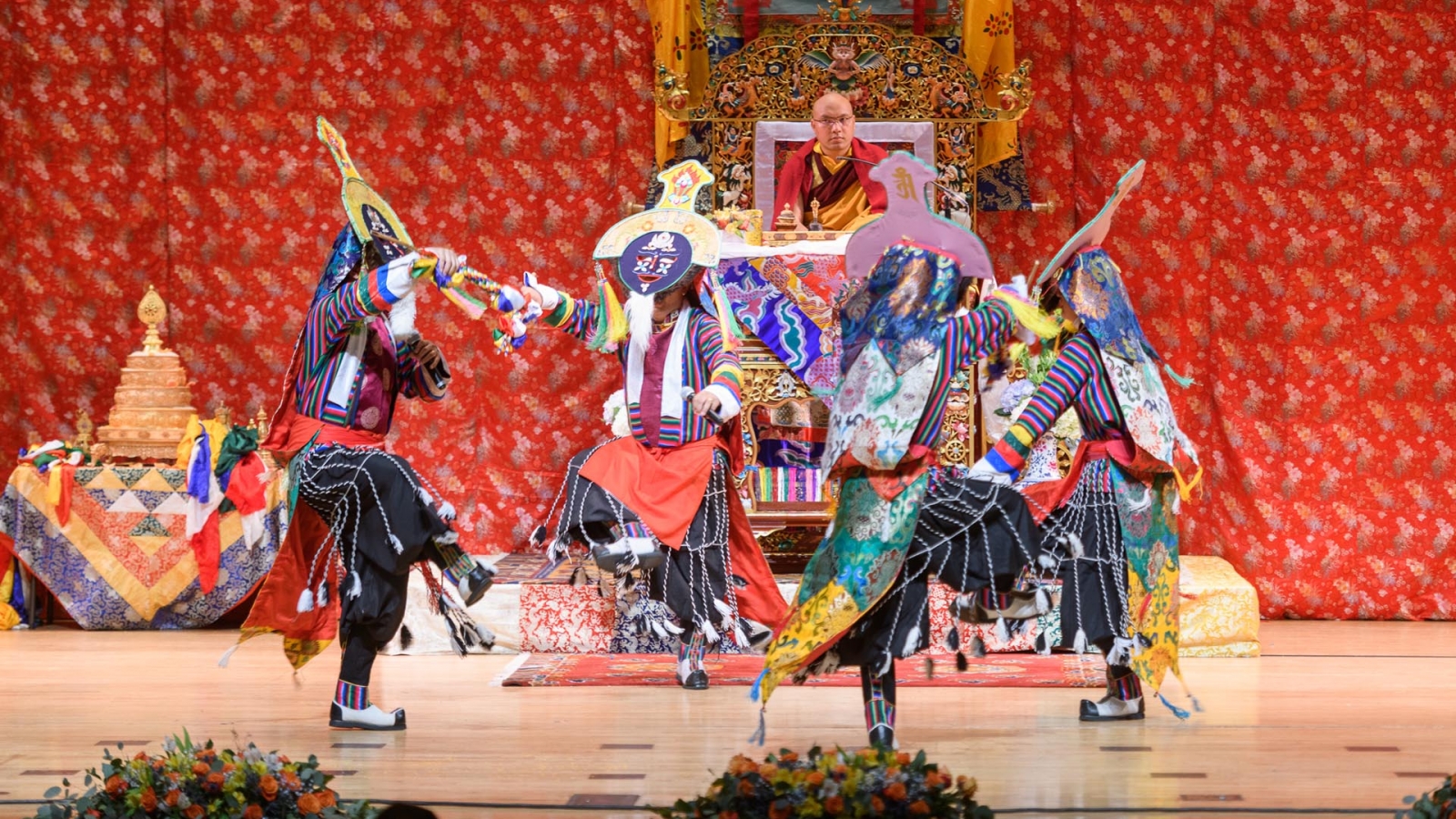Queens College, Flushing, New York
May 27, 2108
On this Sunday of Memorial Day weekend, His Holiness the Karmapa returned to the Colden Auditorium to bestow the empowerment of the Buddha Akshobhya, who is known as the Imperturbable or Unchanging One. The over 2,000 seats were filled with Tibetans and people from the Himalayan region as well as Western and Asian disciples. The stage was radiant with a curtain of bright red brocade that highlighted the scroll paintings of the Buddha above His Holiness’s throne, flanked by Guru Rinpoche on his left and his own paining of Akshobhya on his right, each hung above their individual altars.
The distant sound of drums announced the Karmapa’s arrival as he was led into the hall by the traditional dancers of welcome–four vigorous old men dressed in brilliant color and wearing masks with flowing white beards and eyebrows. A spinning golden umbrella marked the place of the Karmapa as he walked down the aisle to his throne on the stage. After an elegant Bhutanese dance of chö (cutting through) and a lively performance by two snow lions, His Holiness warmly welcomed everyone and began the empowerment. Part way through, he paused to give the following teaching.
“Before the Kagyu Monlam in Bodh Gaya during the last ten years, an accumulation of Akshobhya’s mantra has taken place for two months. My role is to teach the practice and participate in the retreat, and then during the Monlam itself, we perform a ceremony of purification and blessing based on the retreat. Since this has been happening for ten years, many people know that I have an interest in Akshobhya, so I will take this opportunity today to speak about the particular benefits of his practice and my karmic connection with him.
“In the Kangyur (the teachings of the Buddha translated into Tibetan), there is a tantra or a dharani (a long mantra) called The Complete Purification of Obscurations. The title refers to the dharani of Akshobhya, which is said to be the most powerful mantra for purifying all the negative karma each of us has accumulated throughout our beginningless lifetimes in samsara. Among Tibetan Buddhists, the Akshobhya mantra and practice is considered the best way to purify negative karma.
“It is a fundamental Buddhist belief that each and every being has had past lives and will also have future ones. Furthermore, these past lives are considered beginningless, beyond conception or number. During all this limitless time, we have done many things, including negative ones, so we have accumulated a great burden of wrongdoing or negative karma. Most of what we have done we do not remember; we usually forget half the negative actions we have done in this life and not to mention the negative things we did in previous ones. Nevertheless, these actions stay with us as imprints in our mind and form a heavy load we must carry from lifetime to lifetime. In this lifetime, therefore, we need to eliminate some of these imprints and diminish the power of others.
“In addition to the basic situation of having accumulated negative karma, we human beings have become incredibly powerful. Due to scientific and technological advances, what we do with our bodies and say in words can have effects thousands of times greater than during previous centuries. An obvious example is the terrible destruction of the environment that we humans have wrought. In previous centuries, we were unable to produce as much harm to others and our surroundings as we can nowadays. Our technology has made us so powerful that we have created weapons capable of destroying every human being and even the entire planet with all the life forms on it. Due to our technological prowess, therefore, we need to be even more careful in our words and actions in the present than we did in the past.
“This is why the practice of Akshobhya is so appropriate to our time since it is the best way to purify negative karma. In sum, there are two reasons why we should practice Akshobhya. First, we have accumulated an incalculable amount of negative karma since time beyond beginning. Secondly, because of the tremendous power technology has given us, we now must be especially careful with our words and actions.
“In terms of my own connection with the practice of Akshobhya, you could say that I have a karmic connection with the practice, but I would not want to speculate about how profound it is. I can, however, frankly describe the feelings I have about this practice. Several years ago, I translated a sutra containing the dharani of Akshobhya from Chinese into Tibetan. This took quite some time, and while I was translating the text, I had two feelings. One was great appreciation for the Tibetan translators of the past, because I began to understand how much difficulty they must have gone through. Nowadays, we have numerous resources for translators, such as lots of dictionaries and all the information on the web. Past translators did not have these advantages and they must have worked very hard, so my first feeling was one of appreciation for them.
“The other feeling I had arose from the study I went trough to inform my translation. Specifically, I looked at the Sutra of Arraying of Akshobhya’s Pure Land, which is found in a large section of the Kangyur known as the Ratnakuta Sutras. It tells the story of how Akshobhya came to have his name and also describes the features of his realm. When I read this material, I began to really feel something. For example, when Akshobhya first generated bodhichitta and became a bodhisattva, he made an extraordinary and special vow: “From today onward until I achieve buddhahood, I shall never become angry or harm a single living being.” This really moved me.
“What did I feel? I looked at his vow, “From today onward until I achieve buddhahood…” and thought, “This is a very long time.” The sutras explain different lengths of time that it takes from when a person initially generates bodhichitta until they become fully awakened. The shortest possible span is three countless eons, and here “countless” does not mean infinite, but a specific number, namely, ten to the fifty-ninth power or the number one followed by sixty zeros. Multiplying this by three makes for an extremely long time.
“If we do not reflect on this seriously, and just think, “Well, he made that vow. That’s nice. How wonderful.” then nothing will shift inside us. However, if we allow ourselves to be influenced by his example and by this new idea his vow brings up, we might change. But we should reflect, “Could I take this vow for one lifetime? Or just one day?” Usually we do not even think about it, yet this vow gives us a great opportunity. If we take it seriously and make Akshobhya our example, he may represent an entirely new way of thinking and one that could very well enable us to change ourselves for the better.”
On this positive note, the Karmapa concluded his teaching. At the end of the empowerment, he mentioned that the organizers had requested him to bless each person individually and that might be possible. And indeed it was, so for over an hour, he stood in the center of the stage blessing each person with the ceremonial vase.


